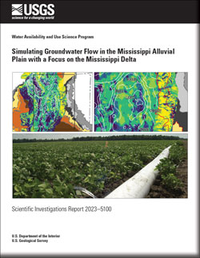Simulating Groundwater Flow in the Mississippi Alluvial Plain with a Focus on the Mississippi Delta
Links
- Document: Report (59.9 MB pdf) , HTML , XML
- Related Works:
- SIR 2023–5051 —Automated construction of Streamflow-Routing networks for MODFLOW—Application in the Mississippi Embayment region
- SIR 2023–5080 —Updated estimates of water budget components for the Mississippi embayment region using a Soil-Water-Balance model, 2000–2020
- Data Releases:
- USGS data release - MODFLOW 6 models for simulating groundwater flow in the Mississippi Embayment with a focus on the Mississippi Delta
- USGS data release - Digital surfaces and site data of well-screen top and bottom altitudes defining the irrigation production zone of the Mississippi River Valley alluvial aquifer within the Mississippi Alluvial Plain project region
- USGS data release - Soil-Water-Balance forecasted climate model output for simulations of water budget components in the Mississippi Embayment Regional Aquifer System, 2020 to 2055
- USGS data release - Model archive and output files for net infiltration, runoff, and irrigation water use for the Mississippi Embayment Regional Aquifer System, 2000 to 2020, simulated with the Soil-Water-Balance model
- Download citation as: RIS | Dublin Core
Abstract
The Mississippi Alluvial Plain has become one of the most important agricultural regions in the United States but relies heavily on groundwater for irrigation. On average, more than 12 billion gallons are withdrawn daily from the Mississippi River Valley alluvial aquifer. Declining groundwater levels, especially in the Delta region of northwest Mississippi and the Cache and Grand Prairie regions of eastern Arkansas, have led to concerns about future sustainability. The U.S. Geological Survey Mississippi Alluvial Plain Project is focused on quantifying the groundwater system in the alluvial plain and the response of groundwater resources to future development. A key objective of the project is to provide updated groundwater flow models supported by extensive data collection and analyses. MODFLOW 6, PEST++, and several open-source python packages were used to develop a simplified, faster running version of the Mississippi Embayment Regional Aquifer Study model that can provide boundary conditions for local inset models, including the Mississippi Delta model described in this report. An automated workflow was used for model construction, history matching, and development of baseline future climate scenarios. The models incorporate information from a Soil-Water-Balance code simulation of the terrestrial water balance, metering-based estimates of water use from thousands of wells, measured and estimated streamflow and stages, and the largest airborne electromagnetic survey flown to date in the United States. Baseline scenarios for the Mississippi Delta under potential future climates were constructed using recharge, surface runoff and irrigation pumping forcings from a future version of the Soil-Water-Balance model, driven by downscaled temperature and precipitation output from 10 general circulation model simulations, including high and moderate carbon emissions pathways.
Results indicate a complex water balance that varies in time and space in terms of the terrestrial recharge, stream leakage, and regional groundwater flow components, which are affected by seasonal forcings, human activity, and alluvial geomorphology. The general circulation model outputs indicate a continued rise in average temperatures but no clear precipitation trend. Increased crop water demand is anticipated from the higher temperatures, resulting in increased irrigation withdrawals to sustain current levels of irrigated agriculture. Simulated drawdowns in groundwater levels at the mid-21st century vary greatly. Under moderate or wet climate scenarios, and in parts of the aquifer that are well connected to surface water, little to no additional drawdown is anticipated. Under dry or warm scenarios, drawdowns of as much as 10 meters or more are possible in parts of the aquifer that are relatively disconnected from surface water. Under dry or warm scenarios, the portion of the Delta with greater than 60 feet of saturated thickness could be reduced from near 100 percent currently (2018) to 80–90 percent by mid-century. Future simulations with the model could include alternative management scenarios to identify options for improving groundwater sustainability. The automated model construction workflows are designed to facilitate regular updating, making this a “living” framework that the Mississippi Department of Environmental Quality and other stakeholders can use for adaptive management going forward.
Suggested Citation
Leaf, A.T., Duncan, L.L., Haugh, C.J., Hunt, R.J., and Rigby, J.R., 2023, Simulating groundwater flow in the Mississippi Alluvial Plain with a focus on the Mississippi Delta: U.S. Geological Survey Scientific Investigations Report 2023–5100, 143 p., https://doi.org/10.3133/sir20235100.
ISSN: 2328-0328 (online)
Study Area
Table of Contents
- Acknowledgments
- Abstract
- Introduction
- Study Area Description and Hydrogeologic Setting
- Conceptual Model
- Modeling Approach
- Results and Discussion
- Assumptions, Limitations, and Suggestions for Future Work
- Summary and Conclusions
- References Cited
- Appendix 1. Groundwater Flow Model Constructions
- Appendix 2. Parameter Estimation and Uncertainty Analysis
- Appendix 3. Additional Model Results
- Appendix 4. General Circulation Models Used in the Future Climate Scenarios
| Publication type | Report |
|---|---|
| Publication Subtype | USGS Numbered Series |
| Title | Simulating groundwater flow in the Mississippi Alluvial Plain with a focus on the Mississippi Delta |
| Series title | Scientific Investigations Report |
| Series number | 2023-5100 |
| DOI | 10.3133/sir20235100 |
| Publication Date | December 22, 2023 |
| Year Published | 2023 |
| Language | English |
| Publisher | U.S. Geological Survey |
| Publisher location | Reston, VA |
| Contributing office(s) | Upper Midwest Water Science Center |
| Description | Report: viii, 143 p.; 4 Data Releases |
| Country | United States |
| State | Arkansas, Louisiana, Mississippi |
| Online Only (Y/N) | Y |
| Additional Online Files (Y/N) | N |


